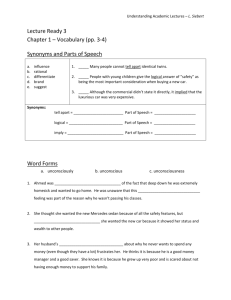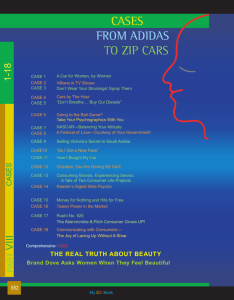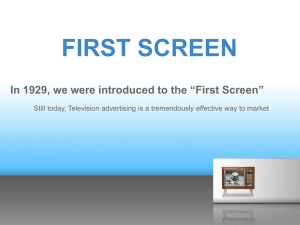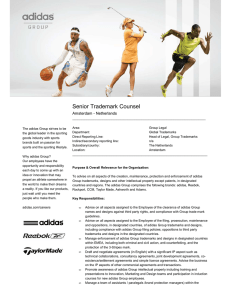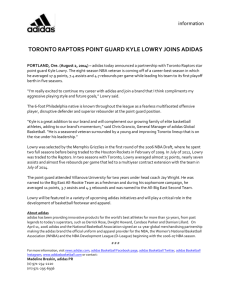Adidas Company Analysis Artifact
advertisement
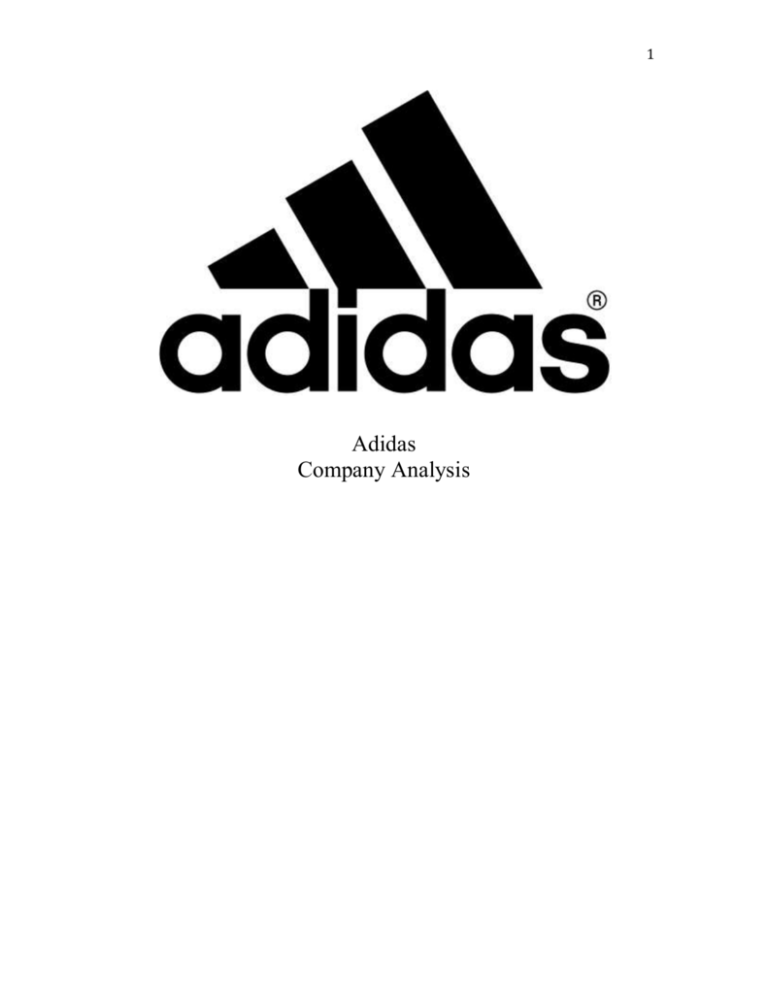
1
Adidas
Company Analysis
2
Executive Summary
Adidas saw their total revenues increase from $10.3B in 2007 to $10.8B in 2008,
but it decreased to $10.4B in 2009. Along with an increase of goods sold expense, from
$5.4B in 2007 to $5.7B, this has lead to a reduction in their net income from $642.0M to
$245.0M.
Debt as a percent of total capital decreased at Adidas over the last fiscal year to
about 32%, it was still in-line with the Textiles, Apparel and Luxury Goods industry's
norm. There are not enough liquid assets to satisfy current obligations, but their
Operating Profits are adequate enough to service the debt.
Adidas increased their debt ratio from 0.63 times in 2007 to 0.64 times in 2008.
Their current assets covered their liabilities for 2009 $1.58 times, which was ironically
the same in 2007. There was decrease in current assets covered by liabilities in 2008 at
$1.35 times.
Adidas is considered one of the leading operators in the sporting goods industry,
but they are in a market that is dominated heavily by Nike. They have done a good job by
establishing their own brand and Reebok (Who they purchased in 2006) as joint operating
models in most markets around the globe. Adidas continues to become more cost
efficient, by eliminating some of their regional headquarters, therefore moving to a more
direct interaction between local markets and global functions.
Adidas has also done a great job with their brand equity. They are the exclusive
uniform and apparel developers for the NBA, WNBA, and D-League since 2006. They
also supplied equipment and apparel to some of the biggest countries like Germany,
Argentina, and France during the 2010 World Cup. This increased their sales by over
13% with the contractual agreements.
With their profound understanding of the customer and the consumer, they are
continuing to strive for more innovation. Also they are pushing the boundaries of their
products and strengthen their competitiveness, therefore driving their long-term value
creation with their shareholders.
3
Company Profile
History of Adidas
Adidas was founded in Germany in 1924 by brothers Adolf and Rudolf Dassler.
They first named the brand "Dassler Shoes" that started getting popular thanks to
sponsored athletes in the Olympics. In 1948, though, Rudolf decides to start its own
company named Puma. That's when, in 1949, Adolf comes up with the three stripes and
changes his company's name to Adidas ('Adi' from his nickname and 'Das' from Dassler).
Adidas was the leading brand among athletes community when, in 1978, Adolf
Dassler passed and his wife Käthe, his son Horst, and his daughter Carry started running
the business. That was a big transition that was completed in the 90's when Robert LouisDreyfus became Adidas CEO: Adidas started moving from being a manufacturing and
sales based company to a marketing company. A hip-hop group called Run-DMC came
and put Adidas on another level just like Michael Jordan did for Nike. They made a song
called "My Adidas" and it was a hit all around the world. Run DMC is still making
Adidas money today just like Michael Jordan is still making Nike lots of money.
Mission
The Adidas Group strives to be the global leader in the sporting goods industry
with sports brands built on a passion for sports and a sporting lifestyle.
Goals (Strategy)
To lead the sporting goods industry with brands built upon a passion for sports
and a sporting lifestyle.
Objectives
To transition to a new structure, the Adidas initiated several measures in 2009 including:
Establishment of joint operating models for the Adidas and Reebok brands in
most markets around the globe.
Elimination of regional headquarters, moving to more direct interaction between
local markets and global functions.
Separation of the responsibility between Global Brands and Global Sales
management on the Board level. Herbert Hainer, Adidas Group CEO, additionally
assumed direct responsibility for Global Sales. At the same time, Erich
Stamminger, Member of the Executive Board of the Adidas Group, took
responsibility for Global Brands.
The new structure will allow Adidas to better leverage the strengths of their management
team and deliver best-in-class service to our consumers and customers.
4
Economic Issues
Not only is the United States dealing with their economic situation, the entire
world has been going through an economic recession. The United States is a global
power when it comes to their economy and with their economic downturn, the rest of the
world began to struggle. Business Week reported that in April of 2008, the International
Monetary Fund (IMF) discovered that global growth would decrease to 3% or less in
2008, thus defining the global recession.
In May of 2009, Adidas reported a huge profit drop, due to the economic
downturn in many of their key markets. The company decided to launch a major global
cost-cutting and reorganization program to even out its finances. In an article by Yahoo
Finances, Adidas said its net profit in the first quarter had decreased dramatically by 97%
to just five million euros (6.7 million dollars in U.S. economic terms) and they also stated
that sales had lost at least 2% to 2.6B euros in the first three months on 2009.
Adidas announced a major reconstruction of their operations that eliminated their
regional headquarters in Europe and Asia. With this, Adidas expected to generate more
than 100 million euros in annual savings. The unemployment rate in the European Union
rose to 9.2% in April 2009 (Saltmarsh, 2009). With that being said, Adidas also decided
to cut over 750 jobs in the first quarter at Reebok, one of their shoe unit divisions. They
currently employ over 38,000 people.
Adidas is prepared to handle these adverse situations. They decided to do joint
operations between themselves and Reebok that would simplify the product creation
process for both brands. Adidas Chairman and CEO, Herbert Hanier, was convinced that
even though operating margin would decline, their earnings per share would eventually
break even.
5
Revenue and Expenditure Summary
Determining the net income or bottom line of a company can be found by looking
at the revenue and expenditures. The following graph shows the quarterly progress of
revenues and expenses over a one year period. Please note that the fiscal year ends Dec.
31 for Adidas and these numbers are based in euros.
From the June 30, 2010 quarter to the September 30, 2010 quarter, Adidas has
been able to grow revenues from 2.9B to nearly 3.5B. Also since they have been able to
reduce the percentage of sales devoted to cost of goods, the net income growth went from
213.0M to 266.0M in the September quarterly.
The total revenues increased every quarter; most of it had to do with the support
from World Cup that took place in the summer of 2010. The company made a profit of
126 million euros for the second quarter. They had a growth of over 13% in sales, which
is based from the result of contracts with Adidas that supplied equipment to some of the
biggest teams in world football (soccer). Countries like Spain, Germany, Argentina, and
France had contracts with Adidas to wear their apparel. Also during the quarter, there was
a 16% increase with the United States Company (Adidas America Inc.), which is based in
Portland, Oregon.
Quarterly Revenues and Expenditures
$4,000,000,000.00
$3,468,000,000.00
$3,500,000,000.00
$2,917,000,000.00
$3,000,000,000.00
$2,500,000,000.00
$2,000,000,000.00
$2,458,000,000.00
$2,674,000,000.00
$3,202,000,000.00
$2,791,000,000.00
$2,439,000,000.00 $2,506,000,000.00
$1,500,000,000.00
$1,000,000,000.00
$500,000,000.00
$-
1
2
3
4
Revenue
$2,458,000,00
$2,674,000,00
$2,917,000,00
$3,468,000,00
Expenditures
$2,439,000,00
$2,506,000,00
$2,791,000,00
$3,202,000,00
Quarter
1 – Dec 31. 2009
2 – Mar 31. 2010
3 – Jun 30. 2010
4 – Sep 30. 2010
6
Assets & Liabilities Summary
The following graphs illustrate the current assets and liabilities of Adidas, in a
quarterly graph and in a yearly (Annually) graph. Looking at the current ratios over the
past three years; in 2007 and 2009 Adidas had $1.58 in assets for every $1.00 in current
liabilities. There were less assets in 2008, which was a decrease from 2007, where Adidas
had $1.35 in assets for every $1.00 in current liabilities.
Quarterly Assets & Liabilities
$6,000,000,000.00
$5,000,000,000.00
$5,641,000,000.00 $5,523,000,000.00
$4,911,000,000.00
$4,485,000,000.00
$4,000,000,000.00
$3,000,000,000.00
$3,602,000,000.00$3,474,000,000.00
$2,836,000,000.00
$3,014,000,000.00
$2,000,000,000.00
$1,000,000,000.00
$0.00
1
2
3
4
$4,485,000,000
$4,911,000,000
$5,641,000,000
$5,523,000,000
Liabilities $2,836,000,000
$3,014,000,000
$3,602,000,000
$3,474,000,000
Assets
Quarter
1 – Dec. 31 2009
2 – Mar. 31 2010
3 – Jun. 30 2010
4 – Sept. 30 2010
7
Annually Assets & Liabilities
$6,000,000,000.00
$4,934,000,000.00
$5,000,000,000.00
$4,485,000,000.00
$4,138,000,000.00
$4,000,000,000.00
$3,000,000,000.00
$3,645,000,000.00
$2,836,000,000.00
$2,615,000,000.00
$2,000,000,000.00
$1,000,000,000.00
$0.00
1
2
3
Assets
$4,138,000,000.00
$4,934,000,000.00
$4,485,000,000.00
Liabilities
$2,615,000,000.00
$3,645,000,000.00
$2,836,000,000.00
Year
1 – Dec. 31 2007
2 – Dec. 31 2008
3 – Dec. 31 2009
8
Financial Analysis/Ratios
Current Ratios
Investopedia states that a current ratio is a liquidity ratio that measures a company's
ability to pay short-term obligations. The current ratio formula is Current Ratio = Current
Assets / Current Liabilities. After doing the calculations, I noticed that the current ratio of
2007 and 2009 were the same with $1.58 times over. There was a decrease in 2008 with
$1.35 times over, possibly due to the global recession.
2007
Current Assets / Current Liabilities = Current Ratio
$4,138,000,000 / $2, 615,000,000 = 1.58 times
2008
Current Assets / Current Liabilities = Current Ratio
$4,934,000,000 / $3,645,000,000 = 1.35 times
2009
Current Assets / Current Liabilities = Current Ratio
$4,485,000,000 / $2,836,000,000 = 1.58 times
Total Debt Ratio
The total debt ratio increased in 2008 to $0.64 in relation to their assets, but decreased to
$0.57 in 2009 for every $1.00. In 2007 Adidas had $0.63 in debt for every $1.00.
2007
Total Debt Ratio = Total Assets – Total Equity / Total Assets
$8,325,000,000 - $3,023,000,000 / $8,325,000,000 = 0.63 times
2008
Total Debt Ratio = Total Assets – Total Equity / Total Assets
$9,533,000,000 - $3,386,000,000 / $9,533,000,000 = 0.64 times
2009
Total Debt Ratio = Total Assets – Total Equity / Total Assets
$8,875,000,000 - $3,771,000,000 / $8,875,000,000 = 0.57 times
Receivable Turnover & Days’ Sales in Receivables
These ratios reflect that Adidas took about 50 days to collect credit sales from 2009. It
was generally higher in 2008 taking about 54 days to collect credit on sales.
2007
Receivable Turnover = Sales / Accounts Receivable
Days’ Sales in Receivables = 365 Days / Receivables Turnover
$10,299,000,000 / $1,459,000,000 = 7.05 times (Receivable Turnover)
9
365 Days / 7.58 times = 51 days
2008
Receivable Turnover = Sales / Accounts Receivable
Day’s Sales in Receivables = 365 Days / Receivables Turnover
$10,799,000,000 / $1,624,000,000 = 6.64 times (Receivable Turnover)
365 Days / 6.64 times = 54 days (This was rounded to the next day)
2009
Receivable Turnover = Sales / Accounts Receivable
Days’ Sales in Receivables = 365 Days / Receivables Turnover
$10,381,000,000 / $1,429,000,000 = 7.26 times (Receivable Turnover)
365 Days / 7.26 times = 50 days
Profit Margin
The following equations show the Profit Margin for Adidas for 2007, 2008, 2009. The
profit margin increased by 6% from 2007 to 2008, but dropped to a remarkable 2.4% in
2009. The sales (purchase) of intangible was down all the across the board on the cash
flow statement. In 2009, Adidas was in the red for majority of the categories on the cash
flow statement as well.
2007
Profit Margin = Net Income / Sales
$551,000,000 / $10,299,000,000 = 0.053 = 5.3%
2008
Profit Margin = Net Income / Sales
$642,000,000 / $10,799,000,000 = 0.059 = 5.9%
2009
Profit Margin = Net Income / Sales
$245,000,000 / $10,381,000,000 = 0.024 = 2.4%
10
Future Trends
Based on their company strategy, Adidas feels they have an understanding of the
consumer and the customer as very essential components to achieve their goal. To
anticipate and respond to the needs of the consumer and customer, Adidas continuously
focuses on creating a culture of innovation, challenging themselves to break with
convention and grasp change. By harnessing the culture, Adidas feels they can push the
boundaries of products, services and other processes to strengthen their competitiveness
and maximize the entire operational and financial performance of the group. This, in turn,
will drive long-term value creation for their shareholders.
Since the United States and the world are slowly recovering from the global
economic downturn. Adidas established several measures to meet their goal and help
stabilize their revenues. They established joint operating models for the Adidas and
Reebok brands in most markets around the globe. They eliminated regional headquarters
in parts of Europe and Asia, thus moving to a direct interaction between local markets
and global functions. They also provided separation of the responsibility between Global
Brands and Global Sales management on the Board level.
In my opinion, Adidas will continue to fair well in their market and through this
economic environment. Though their profit margin decreased dramatically in 2009, I do
not feel that this will be a huge problem for the company in the long run. Adidas will
probably stay in the red for a year or so, but with their initiatives and brand equity, they
should be fine in the years to come.
11
Appendix
Income, Balance, & Cash Flow Statement links
Balance Sheet link (Annual)
http://investing.businessweek.com/businessweek/research/stocks/financials/financials.asp
?ticker=ADDDF:US&dataset=balanceSheet&period=A&currency=native
Balance Sheet Link (Quarter)
http://investing.businessweek.com/businessweek/research/stocks/financials/financials.asp
?ticker=ADDDF:US&dataset=balanceSheet&period=Q&currency=native
Cash Flow Statement Link (Annual)
http://investing.businessweek.com/businessweek/research/stocks/financials/financials.asp
?ticker=ADDDF:US&dataset=cashFlow&period=A&currency=native
Cash Flow Statement Link (Quarter)
http://investing.businessweek.com/businessweek/research/stocks/financials/financials.asp
?ticker=ADDDF:US&dataset=cashFlow&period=Q&currency=native
Income Statement Link (Annual)
http://investing.businessweek.com/businessweek/research/stocks/financials/financials.asp
?ticker=ADDDF:US&dataset=incomeStatement&period=A&currency=native
Income Statement Link (Quarter)
http://investing.businessweek.com/businessweek/research/stocks/financials/financials.asp
?ticker=ADDDF:US&dataset=incomeStatement&period=Q&currency=native
References/Links
Adidas History: http://www.squidoo.com/adidashistory
Adidas becomes Exclusive uniform and apparel for the NBA, WNBA, & DLeague: http://www.nba.com/news/adidas_060412.html
Adidas Cuts Costs after profits sink 97 percent:
http://uk.biz.yahoo.com/05052009/323/adidas-cuts-costs-profits-sink-97percent.html
Adidas Group: http://www.adidas-group.com/en/ourgroup/values/default.aspx
Adidas Group Reports (Financial): http://www.adidasgroup.com/en/investorrelations/assets/agm/2010/AG_2009_En.pdf
Adidas with profit increase with the support of the World Cup: http://financialreport.info/adidas-with-profit-increase-with-the-support-of-the-world-cup/#more531
Current Ratio Definition: http://www.investopedia.com/terms/c/currentratio.asp
Global Recession – Business Exchange: http://bx.businessweek.com/globalrecession/
12
Saltmarsh, Matthew. “Jobless Rate in Europe Rises Further”. New York Times
(2009): http://www.nytimes.com/2009/06/03/business/global/03euro.html?_r=1
The Shoe Game – Adidas History: http://theshoegame.com/Adidas-History.html
